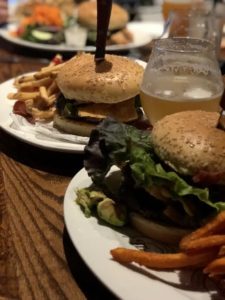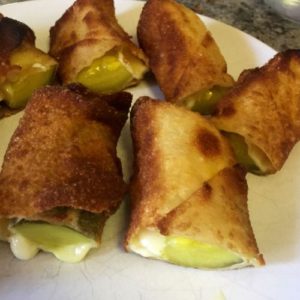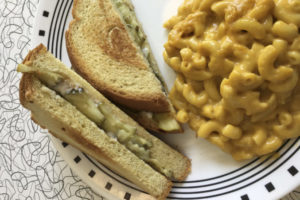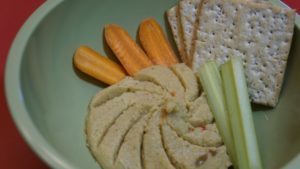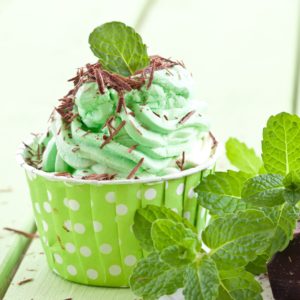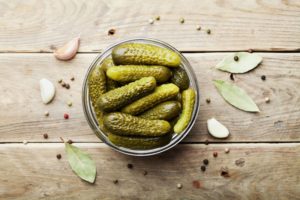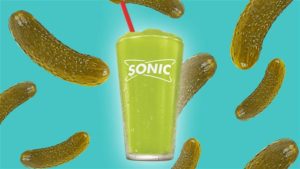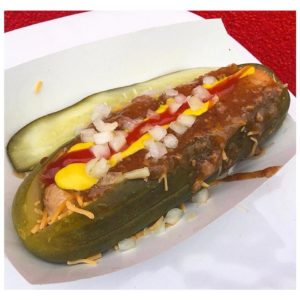The Fix is in
(summited photo)
Pickles are the prefect addition to your burger !
I am pleased to report that
“burgers are the best medicine,” according to the team at The Fix Burger Bar. Turns out, I’ve been doing it all wrong. I solemnly pledge that it’s nothing but bigger macs from here on out.
We’re not talking about a greasy spoon situation; The Fix prides itself on local grinds and house-made sodas. But what they really excel at is volume. The sprawling industrial space regularly accommodates private functions for groups ranging from 10-200 at both lunch and dinner time. The crowd is family friendly and the service is rapid fire.
The Fix offers over 40 toppings to design custom burgers, including the likes of sunnyside eggs, fried pickles, blue cheese, espresso bacon, and even seared foie gras. They take their Americana seriously. If by the grace of god, you landed a Burger-a-Day membership – then you already know this. Each of the 300 lucky Burger-a-Day card carrying members were appropriately guaranteed a burger with fries (or a salad bar meal for non-believers) every day for a year, just as long as they agreed to sit at the bar. The cost to join ran a measly $229, with an ultimate value of $5,415. I know at least one Worcesterite who admits he gained 15 pounds along his Burger-a-Day journey. It is my sincere hope that at least one college sophomore opted to join up rather than spring for a meal plan this year.
The beer selection is approachable and includes local selections from Cold Harbor as well as farmhouse favorites from Oxbow. Variations on the old fashioned range from mad (featuring Mad River maple cask rum) to bossy (have some single barrel Patron reposado tequila with your whiskey bitters). The spiked milkshakes are fun – try Oreo and horchata.
The Fix is just as much about the accoutrements as it is about the burgers. Start with hand-cut potato chips served with sour cream and onion dip ($5). Then, graduate to the fried pickles ($5) complete with crispy crinkles that cling to a fierce horseradish dipping sauce. The roasted garlic and feta hummus ($7) comes with a killer olive relish, but the pita is as dry as you might expect from a bar that specializes in burgers and serves Mediterranean starters as an afterthought.
Servers won’t try to upsell you on Kobe-style grinds ($14) or grass-fed grinds ($11) unless you inquire about the difference. The aptly-named crunchy burger ($13) will come topped with fried prosciutto, parmesan crisp, potato chips, pungent mustard pickles, lettuce and garlic mayo. My favorite selection is the green chile burger ($13) topped with habanero cheddar, roasted poblano and jalapeño, fried corn tortilla strips, avocado, pico de gallo and red leaf lettuce. Liquids are superabundant. I would prefer they gave the greens a quick toss in the sauce, rather than slathering them straight onto the bun. The Fix’s sesame rolls are not hearty enough to absorb a burger’s juices without falling apart, so burger consumption by fork is inevitable but still tasty.
The massive brick building holds a lot of memories for longtime residents of Worcester who recollect Northworks as an industrial hub with a rich history. Carpets have been upended for hardwoods, but the rustic charm and integrity of the space remain intact. Some of the chalkboarding is startling, including what appears to be Boss Tweed devouring a splurge burger. Still, the professional chalkboarding is appreciated.
The Fix is an excellent restaurant for families with young children, large groups of colleagues, and friends hoping to score a table outside on a sunny afternoon. Guests will find the service polished and accommodating no matter the size of their party.

